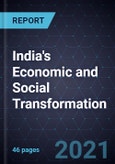Future Growth Potential Driven by Robust Medium-term GDP and Expansive Working-age and Middle-class Populations
India is among the fastest-growing major economies, advantaged by an expanding middle class and working-age population. While signs of a slowdown were evident in 2019, the COVID-19 pandemic has catapulted the economy into a deep recession, similar to the global trend. This research examines the country’s outlook for the next decade and evaluates its socio-economic growth trajectory and transformation.
Looking more closely at the impact of COVID-19 and future outlook, full gross domestic product (GDP) recovery is expected by the early part of fiscal year 2022–2023. Potential unravelling caused by a second wave of the pandemic would likely delay full recovery by a quarter or two. Thereafter, about 6% growth levels are expected. Concerted structural reforms, if implemented, should help put India on a higher growth trajectory during the forecast period of 2020–2030.
In terms of city-based trends, with metros facing saturated markets and resource pressure, the next wave of growth will arise from tier II cities. Several of these cities are expected to outpace Indian metros in regards to economic growth during the next decade. In this scenario, businesses should look to cater to higher middle-class demand, with the number of Indian middle-class households expected to grow from 293 million in 2018 to 386 million by 2030.
On the demographic front, India is enjoying the benefits of a growing working-age population and size, a trend expected to continue for the next decade, in contrast to a declining trend in China. Overall, population density across India is expected to increase. Mumbai, in particular, stands out, ranked as the second-most densely populated city on a global level according to 2017 data.
Healthcare trends reveal a growing incidence of non-communicable diseases amongst the Indian population. While health insurance coverage in the country has typically been low, it appears to have improved following national rollout of the government's Ayushman Bharat scheme back in 2018. Potential expansion of the scheme among the non-poor would help lift health insurance coverage rates.
This research also explores growth opportunities tied to economic and social transformation expected during the next decade, including factors such as manufacturing prospects and population characteristics.
Key Issues Addressed
- What is the 2025–2026 GDP growth outlook for India?
- What are some of India’s key macroeconomic growth opportunities for the next decade?
- What are the expectations for Indian middle-class growth?
- How will global events and trends such as the US elections and supply chain diversification impact India?
- How will India’s population structure evolve up to 2030?
- What does India’s communicable and non-communicable disease profile look like?








